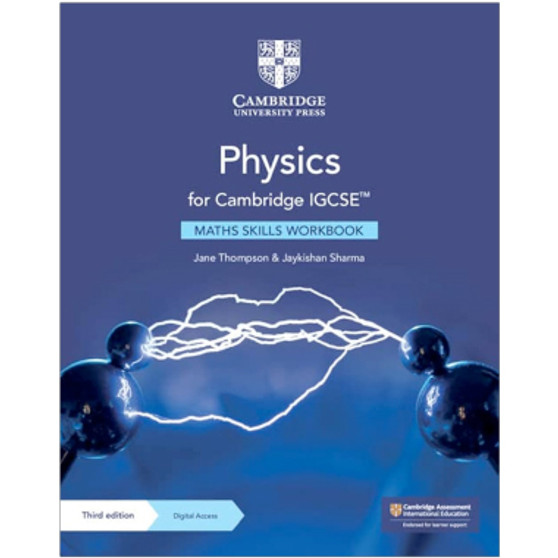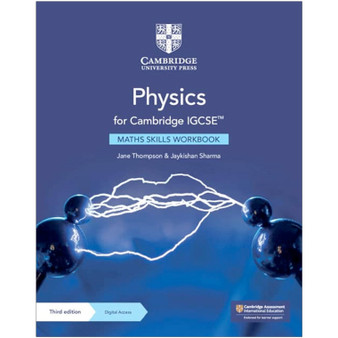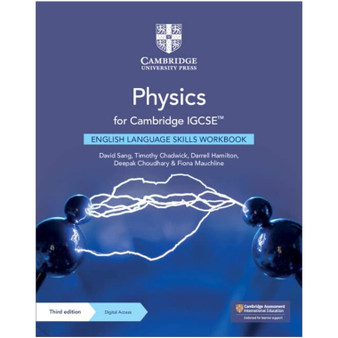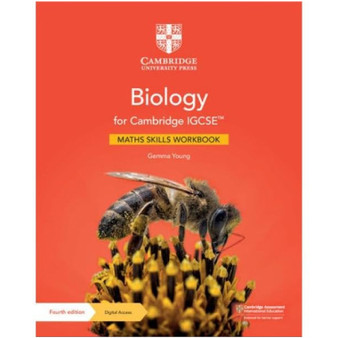Product Description
Cambridge Physics for Cambridge IGCSE™ Maths Skills Workbook with Digital Access (2 Years)
Author/s: Jane Thompson, Jaykishan Sharma
Format: Print/online bundle
The maths skills workbook with digital access help learners to develop their maths skills in the context of the Cambridge IGCSE™ Physics syllabus.
These skills are crosslinked to the coursebook to help students understand how to use them.
Practice exercises provide opportunities for learners to practise each maths skill.
To support students in acquiring these skills, the exercises gradually increase in complexity.
Practice questions provide opportunities for students to practise their skills in an active learning format such as discussion opportunities and pair work.
Exam-style questions give students the chance to apply the skills they have learnt in an exam-style context.
In the last chapter, students will need to select which maths skills they ought to apply in different contexts, without the structure and guidance provided in each of the chapters, helping them become confident, independent learners.
The answers can be found online at www.cambridge.org/go
Features:
- Written by experts in both physics and mathematics based on research carried out by the Nuffield Foundation and the Association for Science Education (ASE).
- Maths skills are crosslinked to other resources in the series to help students understand how to use them.
- Practice exercises gradually increase in complexity to support students in developing maths skills.
- Worked examples illustrate the concept, provide a skills-based step-by-step approach to answering a question, helping learners to develop their thinking processes.
- The ‘Look out’ feature makes students aware of common misconceptions that might be holding them back.
- Exam-style students require students to select which maths skills they ought to apply in different contexts, without the structure and guidance provided in each of the chapters, helping them become confident, independent learners.
- The answers can be found online at www.cambridge.org/go.
Contents:
- Introduction
- 1. Representing values
- Maths focus 1: Using units
- Maths skill 1: Choosing the correct unit for a variable
- Maths focus 2: Using symbols for variables
- Maths skill 1: Using the symbol for each variable and its unit
- Maths focus 3: Determining significant figures
- Maths skill 1: Understanding place value
- Maths skill 2: Determining a correct number of significant figures
- Maths focus 4: Representing very large and very small values
- Maths skill 1: Converting numbers to and from standard form
- Maths skill 2: Interpreting and converting values with unit prefixes to and from standard form
- Maths skill 3: Carrying out arithmetic operations in standard form
- Maths focus 5: Estimating values
- Maths skill 1: Knowing if a number is of the right order of magnitude
- 2. Working with data
- Maths focus 1: Understanding and collecting data
- Maths skill 1: Identifying types of data
- Maths skill 2: Taking measurements
- Maths focus 2: Recording and processing data
- Maths skill 1: Designing results tables
- Maths skill 2: Processing data in tables
- Maths focus 3: Understanding variability in data
- Maths skill 1: Judging the quality of data
- 3. Drawing graphs
- Maths focus 1: Choosing axes and scales
- Maths skill 1: Choosing which variable goes on each axis
- Maths skill 2: Choosing the best axis scales for accuracy
- Maths focus 2: Plotting the points and drawing a best-fit line
- Maths skill 1: Plotting points accurately
- Maths skill 2: Drawing a best-fit line
- 4. Interpreting data
- Maths focus 1: Reading values from a graph
- Maths skill 1: Interpolating values between known data points
- Maths skill 2: Extrapolating a graph
- Maths focus 2: Interpreting straight line graphs
- Maths skill 1: Describing a relationship between variables on a straight-line graph
- Maths skill 2: Determining the gradient and the intercept
- Maths focus 3: Interpreting specific types of linear graphs
- Maths skill 1: Interpreting the intersection of lines on a graph
- Maths skill 2: Calculating the distance travelled from a speed–time graph
- Maths focus 4: Interpreting curves on graphs
- Maths skill 1: Extracting data from a curve on a graph
- Maths skill 2: Determining when a relationship is inversely proportional
- Maths skill 3: Interpreting graphs with regularly repeating patterns
- Maths focus 5: Interpreting data in other types of chart
- Maths skill 1: Interpreting pie charts
- Maths skill 2: Interpreting bar charts
- Maths skill 3: Interpreting Sankey diagrams
- 5. Doing calculations
- Maths focus 1: Understanding equations
- Maths skill 1: Working with equations: the basics
- Maths skill 2: Calculating with percentages
- Maths focus 2: Calculating values using equations
- Maths skill 1: Using two equations
- Maths skill 2: Using an equation of the form y1/y2 = x1/x2
- Maths skill 3: Understanding the impact of changing variable size
- Maths focus 3: Doing more complex calculations
- Maths skill 1: Doing calculations involving several equations
- Maths skill 2: Adding reciprocals
- Maths focus 4: Calculations that involve direction: moments and momentum
- Maths skill 1: Calculating moments
- Maths skill 2: Solving momentum problems
- Maths focus 5: Radioactive decay calculations
- Maths skill 1: Doing particle calculations
- Maths skill 2: Interpreting half-life information
- 6. Working with shape
- Maths focus 1: Solving problems involving shape
- Maths skill 1: Extracting information from diagrams
- Maths skill 2: Calculating using the mathematics of shape
- Maths focus 2: Drawing angles in ray diagrams
- Maths skill 1: Drawing and measuring angles
- Maths focus 3: Working with vectors
- Maths skill 1: Using vector diagrams
- Additional questions involving several maths skills
- Equations
- Glossary
- Acknowledgements.







